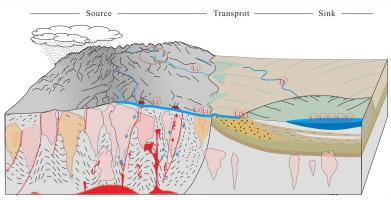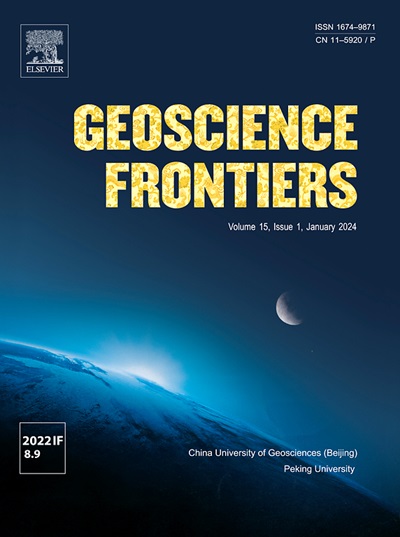IF 8.9
1区 地球科学
Q1 GEOSCIENCES, MULTIDISCIPLINARY
引用次数: 0
摘要
盐湖的源-运-汇动态与资源来源和矿化密切相关,对资源可持续开发和环境保护具有重要意义。结果表明:(1)盐湖中的锂主要来源于地热流体,富锂岩石和古沉积物对其贡献较大。(2)锂输运机制可分为源控制机制和过程控制机制。在源控制系统中,Li主要来源于富Li端元;虽然在运输过程中会发生二次输入和衰减,但由原始源控制的持续高溶解Li负荷保留了可诊断溯源的同位素组成。该体系具有较高的溶解Li通量(>300 μg/L),较高的Li × 103/TDS比值(>0.7), δ7Li值相对较低(1‰~ 6‰,有时低至- 4.8‰)。在过程控制系统中,Li主要来自集水区内的硅酸盐风化,导致下游河流Li通量(20-80 μg/L)对环境条件高度敏感,其源信号经常被二次输入和吸附叠加。这些体系具有较低的Li × 103/TDS比值(0.05 ~ 0.22)和富集的δ7Li值(6‰~ 18‰)。(3) Li及其同位素的汇演化受粘土吸附和蒸发岩沉淀控制,与盐湖发育阶段密切相关。粘土吸附导致Li耗损和同位素分馏,导致演化早期δ7Li特征升高。在后期,由于蒸发岩形成水包层,古粘土吸附能力降低,高盐度条件下的吸附受到抑制,蒸发成为卤水Li同位素演化的主要控制因素。(4)在小型汇盆内建立源-输-汇框架,为认识新生代海相锂同位素演化提供了有价值的参考。构造隆升增强了大陆风化和物理侵蚀,增加了径流中溶解Li和新鲜粘土矿物的供应,而气候变化减少了大陆排放,延长了水岩相互作用时间。这些过程通过增加反应物供应和延长反应时间共同增强了水岩相互作用,提高了河流流入海洋的δ7Li通量,并影响了海洋Li同位素演化。本文章由计算机程序翻译,如有差异,请以英文原文为准。

The evolution of lithium resources and isotopic composition in salt lakes on the Qinghai-Tibet Plateau: A source–transport–sink perspective
The source–transport–sink dynamics of salt lakes are fundamentally tied to resource source and mineralization, which are crucial for sustainable resource development and environmental protection. By integrating published and experimental datasets on lithium (Li) concentrations, Li isotopes, and Li/TDS–Li/Na ratios, this study systematically investigates the characteristics, evolutionary patterns, and driving mechanisms of Li and its isotopes throughout source–transport–sink processes in salt lakes across the Qinghai–Tibet Plateau. The results demonstrate that: (1) Li in salt lakes primarily originates from geothermal fluids, with significant contributions from Li-rich rocks and paleosediments. (2) Li transport mechanisms can be classified into source- and process-control. In source-control systems, Li is largely derived from Li-rich endmembers; although secondary inputs and attenuation occur during transport, the persistently high dissolved Li load governed by the original source retains a diagnostically traceable isotopic composition. This system is marked by high dissolved Li fluxes (>300 μg/L), elevated Li × 103/TDS ratios (>0.7), and relatively depleted δ7Li values (1 ‰ to 6 ‰, occasionally as low as −4.8 ‰). In process-control systems, Li mainly comes from silicate weathering within catchments, resulting in lower riverine Li fluxes (20–80 μg/L) that are highly sensitive to environmental conditions, where source signals are frequently overprinted by secondary inputs and adsorption. These systems exhibit lower Li × 103/TDS ratios (0.05–0.22) and enriched δ7Li values ranging from 6 ‰ to 18 ‰. (3) The sink evolution of Li and its isotopes is controlled by clay adsorption and evaporite precipitation, closely correlating with developmental phases of salt lake. Clay adsorption causes Li depletion and isotopic fractionation, leading to elevated δ7Li signatures in the early evolutionary phase. In later phases, evaporate becomes the dominant control on brine Li isotope evolution due to evaporite formed aquicludes, reduced adsorption capacity of ancient clays, and suppression of adsorption under high salinity. (4) This study offers valuable references for understanding Cenozoic marine Li isotope evolution by establishing a source–transport–sink framework within a small sink basin. Tectonic uplift has enhanced continental weathering and physical erosion, increasing supplies of dissolved Li and fresh clay minerals in runoff, while climate change has reduced continental discharge and extended water–rock interaction time. These processes collectively enhance water–rock interactions through increased reactant supply and prolonged reaction duration, elevating riverine δ7Li fluxes into the ocean and influencing marine Li isotope evolution.
求助全文
通过发布文献求助,成功后即可免费获取论文全文。
去求助
来源期刊

Geoscience frontiers
Earth and Planetary Sciences-General Earth and Planetary Sciences
CiteScore
17.80
自引率
3.40%
发文量
147
审稿时长
35 days
期刊介绍:
Geoscience Frontiers (GSF) is the Journal of China University of Geosciences (Beijing) and Peking University. It publishes peer-reviewed research articles and reviews in interdisciplinary fields of Earth and Planetary Sciences. GSF covers various research areas including petrology and geochemistry, lithospheric architecture and mantle dynamics, global tectonics, economic geology and fuel exploration, geophysics, stratigraphy and paleontology, environmental and engineering geology, astrogeology, and the nexus of resources-energy-emissions-climate under Sustainable Development Goals. The journal aims to bridge innovative, provocative, and challenging concepts and models in these fields, providing insights on correlations and evolution.
 求助内容:
求助内容: 应助结果提醒方式:
应助结果提醒方式:


